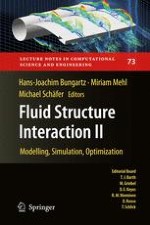Fluid-structure interactions (FSI), i.e., the interplay of some moveable or deformable structure with an internal or surrounding fluid, are among the most widespread and most challenging coupled or multi-physics problems. Although much has been accomplished in developing good computational FSI methods and despite convincing solutions to a number of classes of problems including those presented in this book, there is a need for more comprehensive studies showing that the computational methods proposed are reliable, robust, and efficient beyond the classes of problems they have successfully been applied to.This volume of LNCSE, a sequel to vol. 53, which contained, among others, the first numerical benchmark for FSI problems and has received considerable attention since then, presents a collection of papers from the "First International Workshop on Computational Engineering - special focus FSI," held in Herrsching in October 2009 and organized by three DFG-funded consortia. The papers address all relevant aspects of FSI simulation and discuss FSI from the mathematical, informatical, and engineering perspective.
